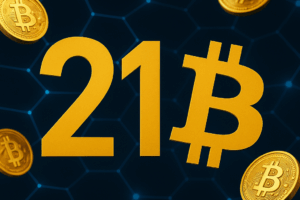Anyone looking at the crypto world from the outside may find with some disillusionment: In many respects, little is left of the motives that triggered Bitcoin developer Satoshi Nakamoto’s efforts almost 15 years ago. Nakamoto’s clear visions and ideas were aimed at nothing less than a revolution of the traditional financial system. The new decentralized world was to herald the end of the dominance of individual large “players”. At the same time, Bitcoin and Co. were to ensure that people who were previously excluded from global banking networks would also have access to the new system. In some parts, this has been quite successful. Especially in African and Asian countries without a comprehensive banking system, millions of users benefit from the possibilities of the blockchain. Instead of a classic bank account, a mobile device is sufficient to carry out transactions cheaply and quickly.
Many Developments in the Crypto World Contradict the Basic Idea of Bitcoin
On the other hand, the development of recent years reveals a clear trend that leaves many convinced crypto and blockchain fans rather dissatisfied. As in the time before the hoped-for “turnaround”, large investors and a relatively small circle of influential participants are now increasingly determining the fortunes of the industry in many networks and on the market as a whole. Or, to put it another way, in many places a manageable minority of users has secured enormous influence. This is evident, for example, in Tesla CEO Elon Musk. In the past, when Musk tweeted about currencies such as Bitcoin or Dogecoin, the prices rose or fell within a very short time. Of course, it was clear early on that cryptocurrencies would remain volatile assets with sometimes very significant price fluctuations until they were fully accepted in the so-called mainstream.
The fact that a single large investor can exert his power so massively is rightly cited by critics as a contradiction to the initial crypto idea. Such influence as in the traditional system on the part of the banks should no longer be possible due to the decentralization of the crypto networks.
Crypto Whales are also Becoming Increasingly Prevalent in the DeFi Sector
This development has been apparent for some time not only in cryptocurrencies of the first hour. The aforementioned “power of the few” is increasingly emerging in the rapidly growing area of decentralized finance (DeFi). At the latest here, the principle actually applied that networks were intended for the entire community instead of for a few investors with strong capital. Experts rightly point out an important aspect. Wherever participants with large assets appear, an environment almost inevitably arises in which precisely those investors realize the highest profits and can play out their supremacy in important decisions for further developments. How accurate this assessment is even in the context of established networks is made clear by data from the DaapRadar platform from the end of October this year for the month of September.
For the young decentralized exchange Curve, the experts at the portal indicated an average volume of around half a million US dollars in connection with Ethereum transactions. This development is, so to speak, a home-made problem. The high transaction fees at this time are simply not affordable for “smaller” investors. Crypto whales, i.e. investors with strong capital, open the door to such fee developments.
The Great Influence of Individuals also Entails Price Risks
The fact that thousands of projects are following in Nakamoto’s footsteps, fixing problems of the world’s first cryptocurrency and pursuing new technological concepts, does little to help the industry for the time being. Another example of many for increasing parallels to the traditional financial system are new currencies such as Shiba Inu, which in fact have little or no discernible benefit. The latter has been developing into an overachiever in the industry for months and has brought astronomical profits especially to large investors. Most recently, a wallet with a SHIB holding of trillions of units triggered a massive price slump. Meanwhile, opinions are divided about the meaning and purpose of the meme coin. Or rather, not really. Because in practice, the application benefit of the currency is still sought without real success. Nevertheless, Shiba Inu is traded as the digital asset that is at the very top of the list of winners in the crypto history so far. In any case, the dominance of crypto whales became as clear here as rarely before.
The price dictate by the big players on the market entails not least the risk of price manipulations. What applies to SHIB can, however, be transferred to a large number of especially smaller coins and tokens. Here as there, investors with smaller investment budgets also benefit. But who makes the big money is obvious. The profiteers are primarily anonymous heavyweights of the crypto market.
Are NFTs Facing a Similar Fate?
A similar development is likely to become increasingly apparent in the area of non-fungible tokens (NFT) through the entry of large corporations such as eBay. Not to mention Bitcoin at all. If you ask experts for their assessment of the distribution of market shares, the verdict is often clear. dYdX founder Anthony Juliano, for example, recently put forward the thesis as one of many industry experts that the lion’s share of the crypto holdings and trading volume could be accounted for by no more than 50, perhaps even only about two dozen companies. The head of the DeFi exchange therefore draws a clear parallel to products such as huge funds that are traded on exchanges such as Wall Street.
In the case of the aforementioned Dogecoin, the development looked very similar to Shiba Inu. As a result, industry media were able to report in the spring of 2021 about a wallet that held almost a third of the total market capitalization of the Dogecoin network with a volume of the equivalent of 22 billion US dollars. Elon Musk reacted to the development at the time by announcing his entry into the currency in the event that large holders sell off a significant portion of their Dogecoin reserves.
Different Significance of Whales in Different Cryptocurrencies?
Information services also made statements in this context. Bloomberg expert Aaron Brown takes a clear position. According to his interpretation, the distribution plays a central role primarily in digital currencies that merely represent a speculation object, but otherwise lack a “solid” economic background. For well-positioned crypto economies, on the other hand, Brown says that the ownership distribution is of secondary importance for the currency value. The bottom line is that such statements must be put to the test on the one hand. On the other hand, the enormous influence of a few remains an annoyance for many convinced crypto users. This is because they had decided to use cryptocurrencies precisely because the technology promised a shift to collective decision-making power. The fact that many digital currencies are now gradually not only arriving in the mainstream, but even adopting its patterns, is anything but satisfactory for many users.
More insights and background information on Bitcoin



